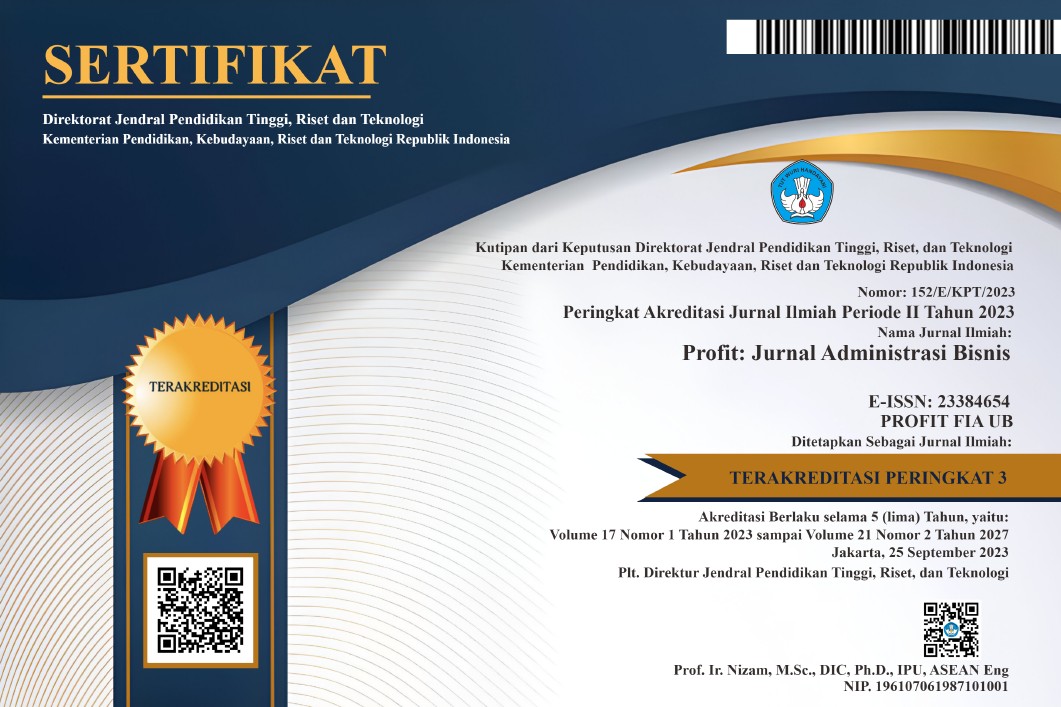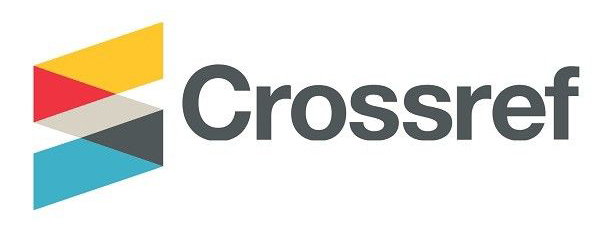PENGARUH RELATIONAL BENEFITS TERHADAP SATISFACTION, TRUST, DAN ADVOCACY
Keywords:
relational benefits, satisfaction, trust, advocacyAbstract
This article aims to review and explore information about research related to relational benefits, satisfaction, trust, and advocacy. Knowing about the effect of relational benefits on satisfaction, trust, and advocacy. Furthermore, knowing about the effect of satisfaction on trust and advocacy also the influence of trust on advocacy. Based on the results of several studies analyzed review, there are differences in influence between variables where it will have an impact not only on large-scale companies, but small-scale companies will also be affected. The factors that influence the relational benefits of satisfaction, trust, and advocacy are: confidence benefits, special treatment benefits, social benefits, convenience benefits, and safety benefits. These factors significantly influence satisfaction, trust, and advocacy. Furthermore satisfaction has a significant influence on trust and advocacy which is then followed by the results of a significant influence by trust on advocacy. But there is one researcher who gets the result that satisfaction does not have a significant effect on advocacy.
References
Alrubaiee, L., & Al-Nazer, N. (2010). Investigate the Impact of Relationship Marketing Orientation on Customer Loyalty: The Customer’s Perspective. International Journal of Marketing Studies, 2(1), 155–174. https://doi.org/10.5539/ijms.v2n1p155
Andaleeb, S. S. (1995). Dependence relations and the moderating role of trust: implications for behavioral intentions in marketing channels. International Journal of Research in Marketing, 12(2), 157–172. https://doi.org/10.1016/0167-8116(94)00020-O
Anderson, E. W. (1998). Customer Satisfaction and Word of Mouth. Journal of Service Research, 1(1), 5–17. https://doi.org/10.1177/109467059800100102
Anderson, E. W., & Sullivan, M. W. (1993). The Antecedents and Consequences of Customer Satisfaction for Firms. Marketing Science, 12(2), 125–143. https://doi.org/10.1287/mksc.12.2.125
Anderson, J. C., & Narus, J. A. (1990). A Model of Distributor Firm and Manufacturer Firm Working Partnerships. Journal of Marketing, 54(1), 42. https://doi.org/10.2307/1252172
Anderson, J. G., & Aydin, C. E. (1994). Overview: Theoretical Perspective and Methodology for The Evaluation of Healthcare Information Systems. In S. J. Jay (Ed.), Evaluating the Organizational Impact of Healthcare Information Systems (pp. 1–29). Thousand Oaks: Sage.
Barnes, J. G. (2003). Secret of Customer Relationship Management (Rahasia Manajemen Hubungan Pelanggan). Yogyakarta: Andi.
Berry, L. L., & Bendapudi, N. (1997). Customers’ Motivations for Maintaining Relationships With Service Providers. Journal of Retailing, 73(1), 15–37. Retrieved from http://ac.els-cdn.com/S0022435997900130/1-s2.0-S0022435997900130-main.pdf?_tid=1005bbd6-26b7-11e7-824c-00000aacb35e&acdnat=1492795514_e0fbe70f1b8ada617062a9e2191675fd
Berry, L. L., & Pasuraman, A. (1991). Marketing Services. Competing Through Quality. New York: Simon and Schuster.
Bloemer, J., & Odekerken-Schroder, G. (2002). Store Satisfaction and Store Loyalty Explained by Customer and Store Related Factors. Journal of Customer Satisfaction, Dissatisfaction and Complaining Behavior., 15, 68–80.
Bolton, R. N., & Lemon, K. N. (1999). A Dynamic Model of Customers’ Usage of Services: Usage as an Antecedent and Consequence of Satisfaction. Journal of Marketing Research, 36, 171–186. https://doi.org/10.2307/3152091
Bolton, Ruth N. (1998). A dynamic model of the duration of the customer’s relationship with a continuous service provider: The role of satisfaction. Marketing Science, 17(1), 45–65. https://doi.org/10.1287/mksc.17.1.45
Crosby, L. A., & Stephens, N. (1987). Effects of relationship marketing on satisfaction, retention, and prices in the life insurance industry. Journal of Marketing Research, 24(11), 404–411.
Crosby, Lawrence A., Evans, K. R., & Cowles, D. (1990). Relationship Quality inServices Selling: An Interpersonal Influence Perspective. Journal of Marketing, 54(3), 68–81.
Dagger, T. S., & O’Brien, T. K. (2010). Does experience matter?: Differences in relationship benefits, satisfaction, trust, commitment and loyalty for novice and experienced service users. European Journal of Marketing, 44(9), 1528–1552. https://doi.org/10.1108/03090561011062952
Darsono. (2008). Hubungan Perceived Service Quality dan Loyalitas: Peran Trust dan Satisfaction sebagai Mediator. The 2nd National Conference UKWS.
Day, G. S. (1990). Market Driven Strategy. New York: The Free Press.
Delgadoâ€Ballester, E., & Luis Munueraâ€Alemán, J. (2001). Brand trust in the context of consumer loyalty. European Journal of Marketing, 35(11/12), 1238–1258. https://doi.org/10.1108/eum0000000006475
Dimitriadis, S. (2010). Testing perceived relational benefits as satisfaction and behavioral outcomes drivers. International Journal of Bank Marketing, 28(4), 297–313. https://doi.org/10.1108/02652321011054981
Dwyer, F. R., Schurr, P. H., & Oh, S. (1987). Developing Buyer-Seller Relationships. Journal of Marketing, 51, 11–27. https://doi.org/10.2307/1251126
Engle, J., Keggeries, R., & Blackwell, R. (1969). Word of mouth communication by the innovator. Journal of Marketing, 33(3), 15–19.
Fitria, N., Troena, E. A., & Hussein, A. S. (2016). The Influence of Relational Benefits and Bank Brand Image to Customer Loyalty Through Sharia Bank Customer Satisfaction (A Study on PT Bank Syariah Mandiri Kediri Branch). Imperial Journal of Interdisciplinary Research, 2(8), 31–38. Retrieved from http://www/onlinejournal.in
Fornell, C. (1992). A national customer satisfaction barometer: the Swedish experience. Journal of Marketing, 56, 55–68.
Fullerton, G. (2003). What Does Commitment Lead to Loyalty? Journal of Service Research, 5(4), 333–344. https://doi.org/10.1177/1094670503251134
Fullerton, G. (2011). Creating advocates: The roles of satisfaction, trust and commitment. Journal of Retailing and Consumer Services, 18(1), 92–100. https://doi.org/10.1016/j.jretconser.2010.10.003
Ganesan, S. (1994). Determinants of Long-Term Orientation in Buyer-Seller Relationships. Journal of Marketing., 58(4), 1–19.
Geyskens, I., Steenkamp, J. B. E. M., Scheer, L. K., & Kumar, N. (1996). The effects of trust and interdependence on relationship commitment Publication date : International Journal of Research in Marketing, 13(4), 303–317.
Gwinner, K. P., Gremler, D. D., & Bitner, M. J. (1998). Relational Benefits in Services Industries: The Customer’s Perspective. Journal of The Academy of Marketing Science, 26(2), 101–114.
Harrison-Walker, L. J. (2001). The Measurement of Word-of-Mouth Communication and an Investigation of Service Quality and Customer Commitment As Potential Antecedents. Journal of Service Research, 4(1), 60–75. https://doi.org/10.1177/109467050141006
Hassan, M., Rafi, A., & Kazmi, S. S. (2016). Impact of differentiated customer service, brand trust, brand commitment, and brand salience on brand advocacy. International Review of Management and Marketing, 6(4), 232–238. Retrieved from www.econjournals.com
Hennig-Thurau, T., Gwinner, K. P., & Gremler, D. D. (2002). Understanding Relationship Marketing Outcomes: An Integration of Relational Benefits and Relationship Quality. Journal of Service Research, 4(3), 230–247. https://doi.org/10.1177/1094670502004003006
Hennig-Thurau, T., & Klee, A. (1997). The impact of customer satisfaction and relationship quality on customer retention: A critical reassessment and model development. Psychology & Marketing, 14, 737–764. https://doi.org/10.1002/(SICI)1520-6793
Hidayah, N., Sari, D., & Helmi, A. (2013). The Relationship Between the Customer Value and Satisfaction To Advocacy Behavior : The Empirical Study in Higher Education. VSRD International Journal of Business and Management Research, 3(8), 303–310. Retrieved from www.vsrdjournals.com
Hill, S., Provost, F., & Volinsky, C. (2006). Network-based marketing: Identifying likely adopters via consumer networks. Statistical Science, 21(2), 256–276. https://doi.org/10.1214/088342306000000222
Ishak, A., & Luthfi, Z. (2011). Pengaruh Kepuasan dan Kepercyaan Konsumen Terhadap Loyalitas: Studi Tentang Peran Mediasi Switching Costs. Jurnal Siasat Isnis, 15(1), 55–66. Retrieved from https://journal.uii.ac.id/JSB/article/view/3192/2901
Jonsson, P., & Zineldin, M. (2003). Achieving high satisfaction in supplier-dealer working relationships. Supply Chain Management, 8(3), 224–240. https://doi.org/10.1108/13598540310484627
Kinard, B. R., & Capella, M. L. (2006). Relationship marketing: The influence of consumer involvement on perceived service benefits. Journal of Services Marketing, 20(6), 359–368. https://doi.org/10.1108/08876040610691257
Koeszegi, S. T. (2004). Trust-building strategies in interorganizational negotiations. Journal of Managerial Psychology, 19(6), 640–660. https://doi.org/10.1108/02683940410551534
Koritos, C., Koronios, K., & Stathakopoulos, V. (2014). Functional vs relational benefits: what matters most in affinity marketing? Journal of Services Marketing, 28(4), 265–275. https://doi.org/10.1108/JSM-10-2012-0213
Lacey, R., & Morgan, R. M. (2008). Customer advocacy and the impact of B2B loyalty programs. Journal of Business & Industrial Marketing, 24(1), 3–13. https://doi.org/10.1108/08858620910923658
Leverin, A., & Liljander, V. (2006). Does relationship marketing improve customer relationship satisfaction and loyalty? International Journal of Bank Marketing, 24(4), 232–251. https://doi.org/10.1108/02652320610671333
Moorman, C., Zaltman, G., & Deshpande, R. (1992). Relationship Between Providers and User of Market Research: The Dynamic of Truth Within and Between Organization. Journal of Marketing, 29(29), 314–328.
Moorman, Christine, Deshpande, R., & Zaltman, G. (1993). Factors Affecting Trust in Market Research Relationships. Journal of Marketing, 57(1), 81. https://doi.org/10.2307/1252059
Morgan, R. M., & Hunt, S. D. (1994). The Commitment-Trust Theory of Relationship Marketing. Journal of Marketing, 58(3), 20–38. https://doi.org/10.1016/0022-0531(82)90041-2
Mowen, J. C., & Minor, M. (2002). Perilaku Konsumen. Jakarta: Erlangga.
Oktora, K., & Achyar, A. (2014). The Effect of Post-Purchased Perceived-Value Towards The Relationship Quality of Hajj and Umrah Travel Agencies in Indonesia. The South East Asian Journal of Management, 8(1), 29–46.
Oliver, R. L. (1997). Satisfaction: A Behavioral Perspective on the Consumer. Retrieved from https://trove.nla.gov.au/version/44887621
Palmatier, R. W., Dant, R. P., Grewal, D., & Evans, K. R. (2006). Factors Influencing the Effectiveness of Relationship Marketing: A Meta-Analysis. 70(10), 136–153. https://doi.org/10.1509/jmkg.70.4.136
Peterson, R. A. (1995). Relationship Marketing and The Consumer. Journal of the Academy of Marketing Science, 23(4), 278–281.
Prayoga, I. M. S., Yasa, N. N. K., & Wardana, M. (2015). Relational Benefit, Kepuasan, Dan Loyalitas Pelanggan Pada Bengkel Pt Honda Dewata Motor. Journal of Management and Entrepreneurship, 17(1), 11–20. https://doi.org/10.9744/jmk.17.1.11-20
Reichheld, F. F. (1996). The Loyalty Effect. Boston: Harvard Business School Press.
Reichheld, F. F., & Sasser, W. E. (1990). Zero Defections: Quality Comes to Services. Harvard Business Review, 68(5), 105–111.
Reynolds, K. E., & Beatty, S. E. (1999). Customer benefits and company consequences of customer-salesperson relationships in retailing. Journal of Retailing, 75(1), 11–32. https://doi.org/10.1016/S0022-4359(99)80002-5
Rosita, A. (2011). Analisis Pengaruh Perputaran Modal Kerja, Perputaran Piutang, Perputaran Persediaan, Return on Equity, Debt to Equity Ratio dan Debt to Asset Ratio terhadap Profitabilitas pada Perusahaan Real Estate dan Property yang terdaftar di Bursa Efek Indonesia.
Sheehan, K. B., & Hoy, M. G. (2000). Dimensions of privacy concern among online consumers. Journal of Public Policy & Marketing, 19(1), 62–73.
Shemwell, J. D., & Cronin, J. J. (1995). Trust and Commitment in Customer / Service-Provider Relationship: Analysis of Differences Across Service Types and Between Sexes. Journal of Customer Service in Marketing and Management, 1(2), 5–75.
Sheth, J. N., & Mittal, B. (2004). Customer Behavior: A Managerial Perspective (2nd ed.). Australia Thomson.
Singh, J. (1988). Consumer complaint intentions and behavior: definitional and taxonomical issues. Journal of Marketing, 52, 93–107.
Smith, S., & Wheeler, J. (2002). Managing the customer experience, Turning customers into advocates (1st editio). New York: Pearson FT Press.
Spekman, R. E., & Carraway, R. (2006). Making the transition to collaborative buyer–seller relationships: An emerging framework. Industry Marketing Management, 35(1), 10–19.
Sunarto, A. (2009). Seluk beluk E-Commerce. Retrieved from http://202.162.35.204:8191/opac/DetailOpacBlank.aspx?id=1024
Susanta, Alhabsji, T., Idrus, M. S., & Nimran, U. (2013). The Effect of Relationship Quality on Customer Advocacy: The Mediating Role of Loyalty. IOSR Journal of Business and Management, 10(4), 41–52. https://doi.org/10.9790/487x-1044152
Tjiptono, F. (2008). Strategi Pemasaran (3rd ed.). Yogyakarta: Andi.
Urban, G. L. (2004). The Emerging Era of Customer Advocacy. MIT Sloan Management Review. Retrieved from https://sloanreview.mit.edu/article/the-emerging-era-of-customer-advocacy/
Verhoef, P. C., Frances, P. H., & Hoekstra, J. C. (2002). The effect of relational constructs in customer refferals and number of services purchased from a multiservice provider: Does age of relationship matter? Academy of Marketing Science, 30(3), 202–216.
Westbrook, R. (1987). Product/consumption based affective responses and post- purchase processes. Journal of Marketing Research, 24(3), 258–270.
White, S. S., & Schneider, B. (2000). Climbing The Commitment Ladder: The Role of Expectations Disconfirmation On Cunsumer’s Behavioral Intention. Journal of Service Research, 2(3), 240–253.
Wulf, K. De, Odekerken-Schroder, G., & Lacobucci, D. (2001). De Wulf, K., Odekerken-Schröder, G. and Iacobucci, D. 2001. Investments in consumer relationship: a cross-country and cross-industry exploration. Journal of Marketing. 65, no. 4: 33-50. Journal of Marketing, 65(4), 33–50.
Yang, S., Song, Y., Chen, S., & Xan, X. (2017). Why are customers loyal in sharing-economy services? A relational benefits perspective. Journal of Services Marketing, 31(1), 48–62. https://doi.org/10.1108/JSM-01-2016-0042
Zeithalm, V. A., Bitner, M. J., Dwayne, D., & Gremier. (2009). Service Marketing: Integration Customer Focus Across the Firm (5th editio). New York: McGraw-Hill.
Zineldin, M. (2006). The royalty of loyalty: CRM, quality and retention. Journal of Consumer Marketing, 23(7), 430–437. https://doi.org/10.1108/07363760610712975
Downloads
Published
Issue
Section
License
The copyright of the received article shall be assigned to the journal as the publisher of the journal. The intended copyright includes the right to publish the article in various forms (including reprints). The journal maintains the publishing rights to the published articles.

This work is licensed under a
Creative Commons Attribution-NonCommercial 4.0 International License
















